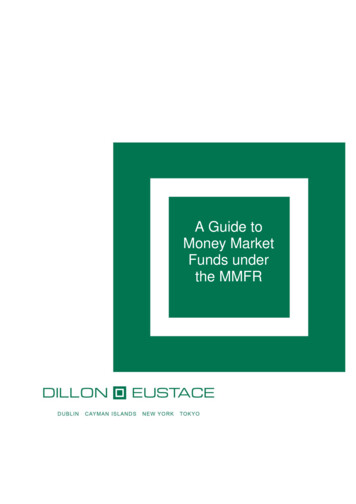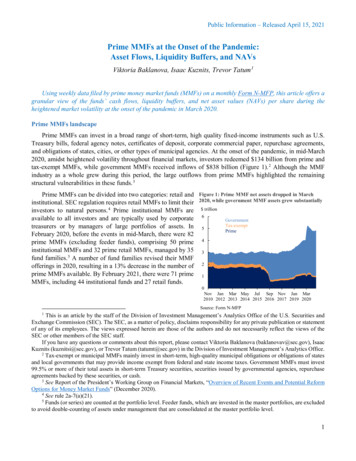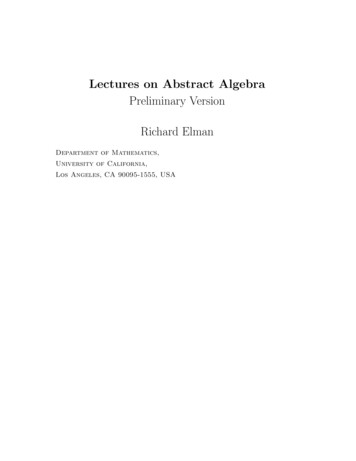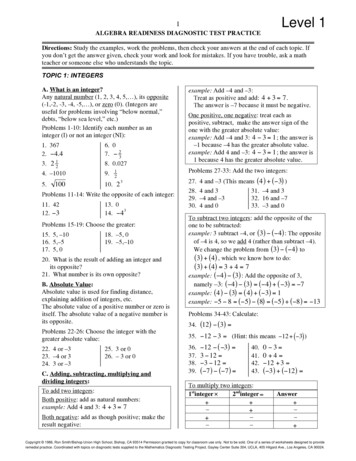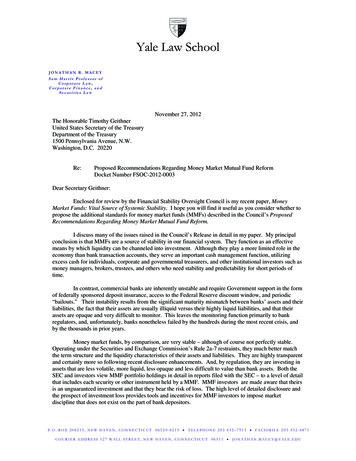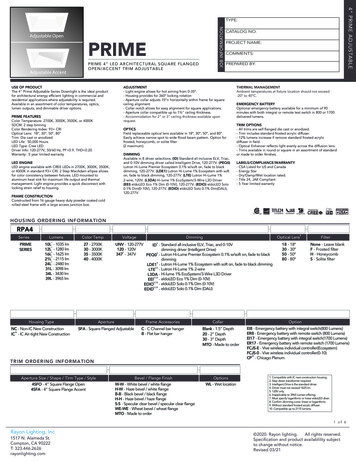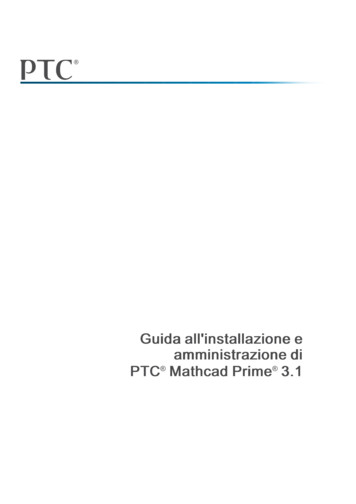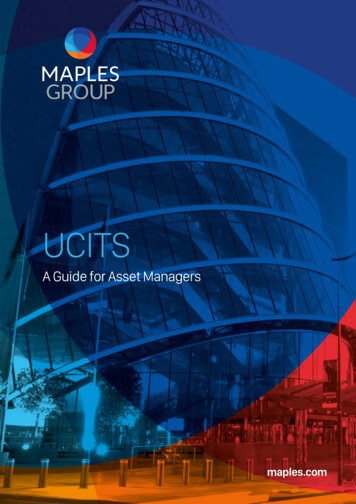
Transcription
Public Information – Released July 21, 2021How Do Prime MMFs Manage Their Liquidity Buffers?Viktoria Baklanova, Isaac Kuznits, Trevor Tatum 1Based on data filed by money market funds (MMFs) on Form N-MFP, this article offers insights aboutthe composition of prime MMFs’ liquidity buffers. The analysis shows that prime MMFs mainly rely ongovernment securities and repos to meet their daily and weekly liquidity thresholds. Prime MMFs’investments in government securities increased during the pandemic, reaching an all-time high of 38% oftheir portfolios in August 2020.MMF liquidityMany investors use MMFs to manage their liquidity needs given that MMFs invest in short-term, highquality debt securities that, under normal market conditions, exhibit limited price volatility. MMFs typicallyprovide somewhat better returns than holding assets in cash. Institutional investors, in particular, makesignificant subscription and redemption requests on a frequent basis, especially during stressed marketconditions. 2 To meet investor needs for liquidity, MMFs are expected to hold a sufficient amount of assetsthat can be quickly converted to cash. Since 2010, SEC rules have included minimum liquidity requirementsfor MMFs, including a minimum of 10% of investments in daily liquid assets (DLA) and a minimum of30% of investments in weekly liquid assets (WLA). 3 MMFs report the size of their DLA and WLA to thepublic daily on their websites. MMFs also report these metrics to the SEC monthly on Form N-MFP. Usingthese data, this article examines the composition of prime MMFs’ daily and weekly liquidity buffers fromOctober 2016 through May 2021, a period that includes the heightened market volatility in March 2020 andthe economic uncertainty that followed.If an MMF’s portfolio falls below the 10% DLA or 30% WLA threshold, it may not acquire any assetsother than DLA or WLA until these thresholds are met. 4 A prime MMF may impose liquidity fees ortemporarily suspend redemptions if the fund’s WLA declines below 30% of its total assets. 5 To date, noMMF has used these tools. On average, prime MMFs have historically maintained DLA and WLA wellabove the regulatory minimums (Figures 1 and 2).This is an article by the staff of the Division of Investment Management’s Analytics Office of the U.S. Securitiesand Exchange Commission (SEC). The SEC, as a matter of policy, disclaims responsibility for any private publicationor statement of any of its employees. The views expressed herein are those of the authors and do not necessarily reflectthe views of the SEC or other members of the SEC staff.If you have any questions or comments about this report, please contact Viktoria Baklanova(baklanovav@sec.gov), Isaac Kuznits (kuznitsi@sec.gov), or Trevor Tatum (tatumt@sec.gov) in the Division ofInvestment Management’s Analytics Office.2See Report of the President’s Working Group on Financial Markets, “Overview of Recent Events and PotentialReform Options for Money Market Funds” (December 2020).3See rule 2a-7(d)(4). Tax-exempt MMFs are not required to maintain 10% of their total assets in DLAs.4See rule 2a-7(d)(4)(iii).5See rule 2a-7(c)(2)(i).11
Public Information – Released July 21, 2021Figure 1: Prime MMFs' average DLA are well in excessof the regulatory minimum of 10% of total assetsFigure 2: Prime MMFs' average WLA are well inexcess of the regulatory minimum of 30% of total assets% of total assets% of total assets100%100%80%average DLADLA regulatory minimum80%60%60%40%40%20%20%0%0%Oct May Dec JulFeb Sep Apr Nov2016 2017 2017 2018 2019 2019 2020 2020Source: Form N-MFPaverage WLAWLA regulatory minimumOct May Dec JulFeb Sep Apr Nov2016 2017 2017 2018 2019 2019 2020 2020Source: Form N-MFPPrime MMFs have historically maintained high levels of DLA and WLADLA are expected to be readily available to meet investor redemptions and generally include cash andsecurities that mature within one business day (or have a daily demand feature). In addition, MMF holdingsof Treasury securities qualify as having daily liquidity. 6 WLA include cash, securities that mature withinfive business days (or that funds can redeem for cash within one week), Treasury securities, and certaingovernment agency securities with remaining maturities under 60 days. 7Prime MMFs can invest in a broad range of short-term, high quality fixed-income instruments such asU.S. Treasury bills, federal agency notes, bank obligations such as certificates of deposit (CD) or timedeposits (TD), commercial paper (CP), repos, and obligations of states, cities, or other types of municipalagencies. Because many of these assets do not qualify as daily or weekly liquid assets, unexpected andrapid shareholder redemptions from a fund may cause DLA or WLA to fall below their regulatoryminimums. For example, at the onset of the pandemic in March 2020, investors withdrew 125 billion fromprime MMFs causing a general reduction of WLA, which approached the 30% threshold for some fundsand fell below 30% in one case. 8 However, according to Form N-MFP filings, no prime MMF reportedDLA declining below the 10% threshold in March 2020, suggesting that these funds maintained availableliquidity to meet daily redemptions up to 10% of the funds’ total assets.See rule 2a-7(a)(8).See rule 2a-7(a)(28).8See, Baklanova, Kuznits, and Tatum “Prime MMFs at the Onset of the Pandemic” SEC Staff Analysis (April2021).672
Public Information – Released July 21, 2021Investments in government securities and reposaccount for the majority of liquid assetsFigure 3: Prime MMF portfolios comprise mainly CP,bank obligations, repos, and government securitiesSince October 2016, when the last round of the2014 MMF reforms was implemented, prime MMFs, onaverage, have allocated approximately 29% of theirinvestments to CP and 31% to banks’ CD or TD (Figure3). During the same period, prime MMFs typicallyinvested approximately 16% of their assets in repos and19% of their assets in government securities. The shareof government securities in prime MMFs increasedduring the pandemic, reaching an all-time high of 38%of these funds’ portfolios in August 2020.% of total assetsOther MunicipalGovernment RepoCD/TDCP100%80%60%40%20%0%Oct May Dec Jul Feb Sep Apr NovPrime MMFs typically invest in repos and Treasury2016 2017 2017 2018 2019 2019 2020 2020securities to meet the majority of their DLA Source: Form N-MFPrequirements, given that most repo investments haveovernight maturities and, as explained above, Treasury securities are considered daily liquid assets. SinceOctober 2016, prime MMFs have invested an average of 72%, of their DLA in repos and Treasury securities(Figure 4).9 At the onset of the pandemic, the share of Treasury securities in DLA increased and reachedan all-time high of 63% of prime MMF portfolios in June 2020, while the share of repos declined to 23%,below the historical average (Figure 5). On the other hand, even though prime MMFs invest a larger partof their assets – 61%, on average – in CP and banks’ CD or TD, these assets account for less than a quarterof DLA.Figure 4: Investments in Treasury securities and reposaccount for 72% of prime MMFs' DLAFigure 5: The share of Treasury securities in primeMMFs' DLA increased sharply during the pandemic% of 34%OtherRepoMunicipal TreasuryCD/TD CP80%60%40%Treasury38%Note: percentages are based on average monthly allocations toeach asset type since October 2016Source: Form N-MFP20%0%Oct May Dec Jul Feb Sep Apr Nov2016 2017 2017 2018 2019 2019 2020 2020Source: Form N-MFPPrime MMFs’ investments in Treasury and government agency securities account, on average, for 35%of these funds’ WLA (Figure 6). Investments in repos account for 28% of WLA, on average. Similar to theDLA observations, the share of government securities prime MMFs used as WLA increased during thepandemic, reaching an all-time high of 59% in June 2020 (Figure 7). CP and banks’ CD or TD account, onSee, Baklanova, Kuznits, and Tatum “Primer: Money Market Funds and the Repo Market” SEC Staff Analysis(February 2021).93
Public Information – Released July 21, 2021average, for 33% of prime MMFs’ WLA. In 2020, amidst the pandemic, prime MMFs reduced the use ofCP and banks’ CD or TD for WLA purposes well below the historical average, reaching an all-time low of5% of WLA (for CP) and 9% of WLA (for CD and TD) in December 2020.Figure 6: Investments in repos, Treasury andgovernment agency securities account for 62% of primeMMFs' WLAFigure 7: The share of government securities in primeMMFs' WLA increased sharply during the pandemicOther MunicipalGovernment Repo% of P11%40%Treasury27%20%Gov't agency7%0%Oct May Dec Jul Feb Sep Apr Nov2016 2017 2017 2018 2019 2019 2020 2020Note: percentages are based on average monthly allocations toeach asset type since October 2016Source: Form N-MFPSource: Form N-MFPThe data show that nearly all prime MMF investments in repos have historically been used to meetDLA and WLA thresholds (Figure 8). In addition, most prime MMF investments in government securitiesare used as WLA (Figure 9). In contrast, only a small portion of total CP investments by prime MMFs areused as DLA (5% of the total CP investments, on average) and WLA (11% of the total CP investments, onaverage) (Figure 10). Lastly, only 18% of prime MMF investments in banks’ CD and TD, on average, areused as DLA and 22% of these investments, on average, are used as WLA (Figure 11).Figure 8: Nearly all prime MMFs' repo investments areused as DLA and WLA billionFigure 9: Nearly all prime MMFs' investments ingovernment securities are used as WLA al repo investmentsWLA reposDLA reposOct May Dec Jul Feb Sep Apr Nov2016 2017 2017 2018 2019 2019 2020 2020Note: repos back by all types of collateral are included.Source: Form N-MFP0500Total investments ingovernment securitiesWLA government securitiesDLA government securities4003002002001001000Oct May Dec Jul Feb Sep Apr Nov2016 2017 2017 2018 2019 2019 2020 20200Source: Form N-MFP4
Public Information – Released July 21, 2021Figure 10: Only a limited amount of prime MMFs' CPinvestments are used as DLA or WLA billionFigure 11: Historically, around a quarter of primeMMFs' CD/TD investments have been used as WLA 00100500400Total CP investmentsWLA CPDLA CP0Oct May Dec Jul Feb Sep Apr Nov2016 2017 2017 2018 2019 2019 2020 2020Source: Form N-MFP0Total CD/TD investmentsWLA CD/TDDLA CD/TD0Oct May Dec Jul Feb Sep Apr Nov2016 2017 2017 2018 2019 2019 2020 20205004000Source: Form N-MFP5
Based on data filed by money market funds (MMFs) on . Form N -MFP, this article offers insights about the composition of primeMMFs' liquidity buffers. The analysis shows that prime MMFs mainly rely on government securities and repos to meet their daily and weekly liquidity thresholds. Prime MMFs'
